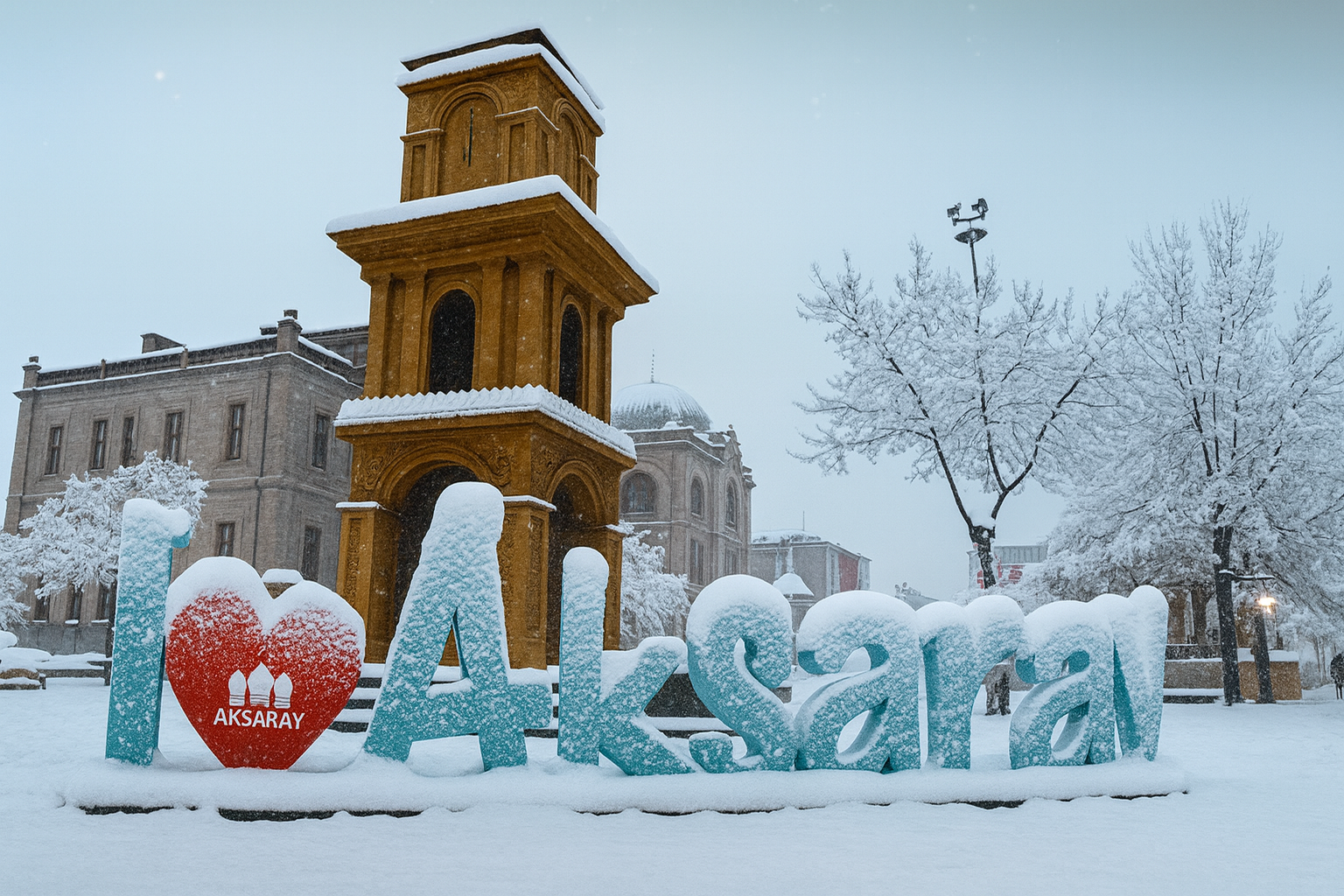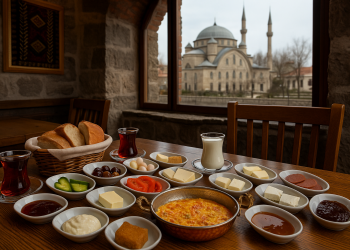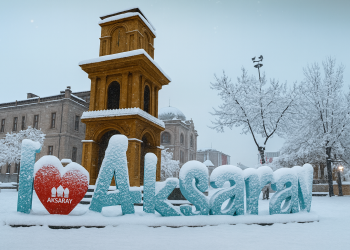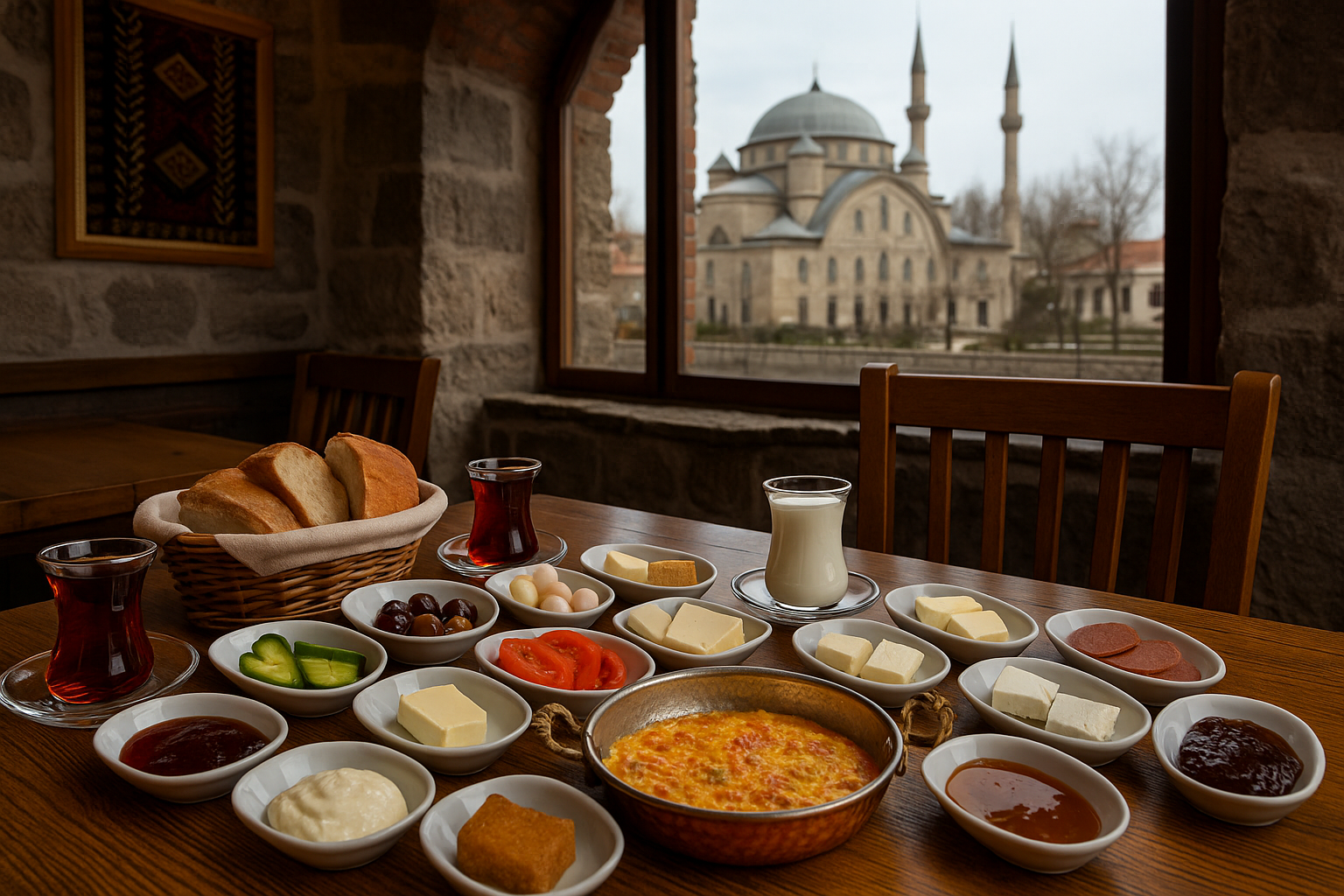Located in the heart of Turkey and attracting attention with its history and natural beauty, Aksaray is one of the hidden gems of the Central Anatolia Region. With its thousands of years of history, this city, located at the crossroads of civilizations, offers visitors a unique experience with its rich historical heritage, unique culture, and natural wonders. Home to many civilizations, from the Hittites to the Romans, Seljuks, and Ottomans, Aksaray sheds light on the past with its historical structures and archaeological remains.
The city is not only fascinating for its history but also for its nature. Part of the Cappadocia region, Aksaray is home to one of the world’s most impressive canyons, the Ihlara Valley. The frescoed rock churches in the valley and the cool waters of the Melendiz River are elements that attract nature and history lovers. In addition, the majestic silhouette of Mount Hasan offers an attractive environment for activities such as hiking and mountaineering.
In this article, we will explore many aspects of Aksaray, from its historical riches to its natural beauty, local delicacies, and cultural fabric. If you want to travel to one of Turkey’s lesser-known but well-deserving cities, get ready to get to know Aksaray up close.
The History of Aksaray
In the multi-layered historical map of Anatolia, Aksaray has a unique chronology that began with traces dating back to 8200 BC and has continued uninterrupted to the present day. Aşıklı Höyük, located on the city limits, bears witness to the birth of agriculture, animal husbandry, and mudbrick architecture as one of the world’s first village settlements; it also contains the earliest evidence of Neolithic medicine with examples of trepanation (skull surgery).
- A Multi-National Crossroads from the Hittites to the Persians
During the Hittite Empire, the city’s name appears on Hittite tablets as Kuršaura (“land of tablets”), highlighting both the region’s culture of record-keeping and its ceramic wealth. Throughout the Assyrian (713 BC), Cimmerian, Phrygian, and Lydian-Median dominations, Aksaray maintained its identity as a strategic market where north-south and east-west caravan routes converged. Coming under Persian control in the 530s BC, it became one of the main stops on the Royal Road.
- Hellenistic and Roman-Byzantine Periods
After Alexander the Great’s campaigns, the region was incorporated into the Kingdom of Cappadocia. The city, reorganized as the new capital of King Archelaus (1st century BC), took the name “Archelais”; it was incorporated into the Roman imperial network and developed its walls, baths, and coins. A Byzantine coin dated 593 bearing the inscription “Aksara” demonstrates the city’s importance in the Middle Ages. Marked as Ta Aksara/Taksara on Byzantine maps, the city served as a border garrison and bishopric center.
- Islamic Conquests and the Turkish-Seljuk Stamp
Aksaray, which became a buffer zone with Arab-Abbasid raids in the 7th-10th centuries, came under Seljuk rule after the 1071 Battle of Malazgirt and began to be called “Ak-Sera.” Magnificent caravanserais such as Sultanhanı, Ağzıkarahan, and Alay Han were built to boost trade, securing the Anatolian leg of the Silk Road.
- From the Ottoman Empire to the Republic
First appearing in sources in the 15th century as “Aksaray,” the city continued to be a sanjak (district) under the Konya province during the Ottoman period and was known for its trade in silk, carpets, and grain. After becoming part of the Republic of Turkey in 1920, it was a province between 1920 and 1933, then a district, and regained its provincial status on June 15, 1989. Thus, Aksaray has combined its historical heritage spanning over 8,000 years with a modern Anatolian city identity; today, it still preserves its character as an open-air museum stretching from the past to the future with its mounds, caravanserais, and rural Ottoman fabric.
The name Aksaray has been shaped by the influence of many different civilizations throughout history and has been known by various names. These name changes provide important clues reflecting the city’s multi-layered history and cultural richness.
The Origin of the Name Aksaray
The name Aksaray has been shaped by the influence of many different civilizations throughout history and has been known by various names. These name changes provide important clues reflecting the city’s multi-layered history and cultural richness.
- Kurşaura (Hittite Period)
The oldest known name of Aksaray is **“Kurşaura”**, which appears in Hittite texts. In the Hittite language, “Kurşa” means plate or tablet. This expression suggests that Aksaray was a center of record-keeping and production in a historical context. At the same time, the rich pottery culture and the existence of written documents in the region reinforce the meaning behind this name. Kurşaura is the oldest name indicating that Aksaray has been an important settlement since the Neolithic Age.
- Archealis (Cappadocia Kingdom Period)
During the reign of King Archelaus, who was of Macedonian origin, the city took the name “Archealis.” This name means “the city of Archelaus” and shows how Aksaray became a personal-administrative center during the Hellenistic period. During this period, the city was one of the important cities of the Kingdom of Cappadocia.
- Ta/To Aksara – Taksara (Byzantine Period)
By the Byzantine period, the city appeared on maps as “Ta Aksara,” “To Aksara,” or “Taksara.” These names are adapted to the Greek language structure and reflect the city’s administrative and strategic importance during the Byzantine period. These names are also found on coins from this period.
- Ak-Sera (Seljuk Period)
After the 1071 Battle of Malazgirt, when the region came under Turkish control, the city began to be referred to as “Ak-Sera.” This usage, which is close to Turkish, may be derived from the words ‘ak’ (clean, bright) and “sera” (city). From this period onwards, the name gradually approached its current form.
- Aksaray (Ottoman Period)
The city’s current name, “Aksaray,” was first used officially in Ottoman archival documents in the 15th century, particularly during the reign of Sultan Suleiman the Magnificent. While the word “ak” emphasizes nobility, cleanliness, and grandeur, the word “saray” gives the city a sense of centrality and splendor. This name has survived to the present day, and the city continues to be known by this name.
Aksaray’s administrative structure has changed many times throughout history, holding different statuses from ancient times to the present day. This change reflects both the strategic importance of the region and the political and administrative transformations over time.
When Did Aksaray Become a Province?
Aksaray’s administrative structure has changed many times throughout history; it has had different statuses from ancient times to the present day. This change reflects both the strategic importance of the region and the political and administrative transformations over time.
- Ancient and Medieval Period
In ancient times, Aksaray stood out as the capital of the region called Garsauritis. In the 300s AD, it became an important city belonging to the Kingdom of Cappadocia. During this period, the city was known as “Archelais” and was one of the political and administrative centers of the kingdom.
- Beyliks and Ottoman Period
With Turkish rule, in the 1400s, Aksaray was administered as a district under the Karaman Beylik. Under Ottoman rule, in the 16th century, especially during the reign of Sultan Suleiman the Magnificent, Aksaray became a sanjak under the Konya province. This situation continued for a long time, and the city was also referred to with this status in Ottoman records.
- Republican Era
With the founding of the modern Republic of Turkey, Aksaray officially gained provincial status for the first time in 1920 during the Atatürk era. However, this situation did not last long; with the administrative reorganization in 1933, its provincial status was revoked, and it was made a district under Niğde.
- Re-establishment as a Province (1989)
In line with the demands of the people of Aksaray and the developing potential of the region, it was granted provincial status again by a decision dated June 15, 1989. From this date onwards, Aksaray took its place on Turkey’s administrative map as an independent province once more.
Throughout its historical process, Aksaray has evolved from an ancient capital to an Ottoman sanjak, then fluctuated between being a province and a district during the Republican era, and finally attained permanent provincial status in 1989. This situation is indicative of the city’s historical significance and its value in the collective memory.
Is There a Connection Between the City of Aksaray and the Aksaray District in Istanbul?
Yes, there is a direct historical connection between the city of Aksaray and the Aksaray district in Istanbul. This connection was established as part of the settlement policies implemented by Fatih Sultan Mehmet after the conquest of Istanbul.
After the conquest of Istanbul in 1453, the city was largely in ruins and its population had decreased significantly. Therefore, Sultan Mehmed the Conqueror brought people from various regions of Anatolia and settled them in different districts of the city in order to revitalize and Turkify the new capital, Istanbul. This settlement movement not only increased the population but also played an important role in the social, cultural, and economic reconstruction of Istanbul.
Within this framework, families brought from what is now Aksaray province were also settled in a specific area within the walls of Istanbul. The neighborhood where they were settled was named “Aksaray” in memory of their place of origin. Over time, this area became one of the most densely populated and well-known neighborhoods in Istanbul.
This example is one of the rare examples showing how city names were transferred to other settlements during the Ottoman period to name new settlements. Thus, a cultural and historical link was established between Aksaray in Anatolia and Aksaray in Istanbul, and this link has been preserved for centuries.
The Economy of Aksaray
Aksaray, with its fertile lands and vast plains in the Central Anatolia Region, is an important center for agriculture and livestock farming in the Turkish economy. Approximately half of the city’s land is suitable for agriculture, and about 75% of the population earns their livelihood from agriculture and livestock farming. This shows that Aksaray’s production and livelihood culture is largely based on rural activities.
- Agriculture
A wide variety of agricultural products are grown in Aksaray. Cereals such as wheat and barley, legumes such as lentils and chickpeas, and industrial crops such as sugar beets, sunflowers, and potatoes are grown on large areas. In addition, various vegetables and fruits are grown in accordance with the climatic conditions of the region. With the spread of modern agricultural techniques, productivity has increased, and irrigation projects have made larger areas suitable for agriculture.
- Livestock
Livestock is another pillar of Aksaray’s economy. Sheep farming, in particular, stands out in terms of both numbers and product diversity. Angora and hair goats are also raised in the city; the wool from these animals is used in traditional handicrafts. Poultry farming is also an important source of livelihood at the village and town level.
- Industry
Alongside its agriculture and livestock-based economy, Aksaray’s industrial sector is also growing steadily. Agriculture-based industries such as food processing, flour and feed mills, and dairy product facilities are particularly widespread. In addition, sectors such as machinery and metal goods manufacturing, automotive supply industry, and mining have also experienced notable growth in recent years. Investments in the organized industrial zone are strengthening Aksaray’s industrial profile.
- Handicrafts
Carpet and rug weaving constitutes the cultural dimension of the city’s economy. This traditional form of production, which is carried out especially in small towns and rural areas, contributes to the family economy and allows local motifs to be kept alive.
Population of Aksaray
Aksaray is one of the cities located in the Central Anatolia Region of Turkey that has shown steady population growth in terms of its demographic structure. According to data from the Turkish Statistical Institute (TÜİK), the total population of Aksaray was 429,069 in 2021. This figure represents a significant increase compared to the population of approximately 377,000 in 2010 and is directly related to the city’s socioeconomic development.
- Gender and Distribution
Men make up 50.7% of Aksaray’s population, while women make up 49.3%. This ratio indicates a gender distribution that is quite parallel to that of Turkey as a whole. The fact that the gender balance of the population is maintained is an important indicator of the city’s overall demographic stability.
- Population Density and Growth Rate
Considering the area of Aksaray, there is an average of 54 people per square kilometer in the city. This ratio shows that Aksaray is neither a densely populated nor a sparsely populated province. The city’s annual population growth rate is calculated at 1.43%; this ratio is close to the Turkish average and indicates that living conditions in Aksaray are positive in terms of migration, birth rates, and quality of life.
- Ranking in Turkey
In terms of population size, Aksaray ranks 46th among Turkey’s most populous cities. This position places it in the category of medium-sized cities nationwide. With its economic activities, transportation infrastructure, and the influence of its rural-urban balance, Aksaray appears to be a city that both attracts migration and grows through its internal dynamics.
Geography of Aksaray
Aksaray is located in the south of the Central Anatolia Region and has a geography shaped by volcanic mountains, plateaus, plains, and valleys in terms of its geological structure. The city is built on wide plains formed by lava and tuff deposits from volcanic mountains such as Mount Hasan, Mount Melendiz, and Mount Ekecik. Thanks to these structures, it is rich in crater lakes, soda ponds, and thermal water sources.
Aksaray’s Valleys and Canyons
- Ihlara Valley
Located in the Güzelyurt district of Aksaray, Ihlara Valley is a deep canyon formed by thousands of years of erosion by the Melendiz River. Hundreds of churches and monasteries carved into the rocks along the valley are decorated with frescoes from the Byzantine period. It attracts visitors from all over the world with both its natural beauty and historical texture.
- Belisırma Valley
Located beyond Ihlara Valley, Belisırma Village stands out with its peaceful atmosphere surrounded by nature and walking trails along the Melendiz River. It is also a cultural stop with its numerous rock churches.
- Monasteries Valley
Located in Güzelyurt, this valley stands out with its conical rock blocks, ancient monastery structures, and its history of silk worm thread production. It also housed libraries where translations of classical works were made.
- Sofular Valley
This region, which is part of the Gülağaç district, is like an open-air museum with its underground cities, stone houses, and rock-carved structures dating back 10,000 years.
Lakes, Reservoirs, and Hot Springs of Aksaray
- Narlıgöl (Acıgöl)
Located on the Niğde-Aksaray border, this crater lake is known for its high mineral content. It is believed that the calcium, bicarbonate, and sodium it contains are beneficial for conditions such as psoriasis, rheumatism, and vascular diseases.
- Salt Lake
A significant portion of Salt Lake, which has Turkey’s largest salt reserve, is within the borders of Aksaray. The lake is home to bird species such as flamingos and spoonbills and has a unique ecosystem.
- Bakı Lake
Located in the Gülağaç district, this lake is an ideal stop for nature lovers with its green surroundings, peaceful atmosphere, and bird watching opportunities.
- Ziga Hot Springs
This spa center in Güzelyurt is preferred for the treatment of rheumatic and skin diseases with its high-temperature thermal waters. It is one of the region’s most well-known health spots for medical tourism.
Museums and Archaeological Sites
Aksaray has a rich cultural heritage stretching from prehistoric times to the Ottoman Empire. Notable archaeological sites include:
- Aksaray Museum
- Aşıklı Höyük (Neolithic settlement)
- Acemhöyük (Bronze Age palace settlement)
- Ancient City of Nora
- Musular Höyük
- Selime Monastery and Cathedral
- Ziga Hot Springs
Mosques and Tombs
- Aksaray Ulu Mosque: Built by Karamanoğlu Mehmet Bey, it is a historic structure famous for its stonework.
- Yunus Emre Tomb: Built in honor of Yunus Emre, one of the symbolic figures of Anatolian Sufism.
- Somuncu Baba Complex: Built for Sheikh Hamid-i Veli, this complex consists of a mosque, a hermitage, and museums.
- Many other historical places of worship are also located in the city, such as the Crooked Minaret (Red Minaret), Kaya Mosque, Selime Sultan Tomb, and Kilise Mosque.
Churches
Aksaray is home to the impressive church architecture of Cappadocia. The main churches are:
- Saint Anargiros, Sivişli Church, Selime Cathedral, High Church, Red Church,
- Pürenli Seki, Kokar, Eğritaş, Sümbüllü, Yılanlı, Saint Georges (Kırkdamaltı),
- Bahattin Samanlığı, Direkli, Ala Church, Karagedik Church
These structures offer important frescoes and architectural examples from both a religious and artistic perspective.
Caravanserais and Inns
Throughout history, Aksaray has been located at the intersection of east-west and north-south trade routes. For this reason, many inns and caravanserais were built during the Seljuk period:
- Sultanhanı Caravanserai: It is the largest caravanserai in Turkey and was built by Alaeddin Keykubat.
- Ağzıkarahan, Alayhan, Öresin Han, Yerköy Hanı, Akhan are other important structures of this period. These caravanserais were important trade centers where merchants stayed and transported their goods safely.











